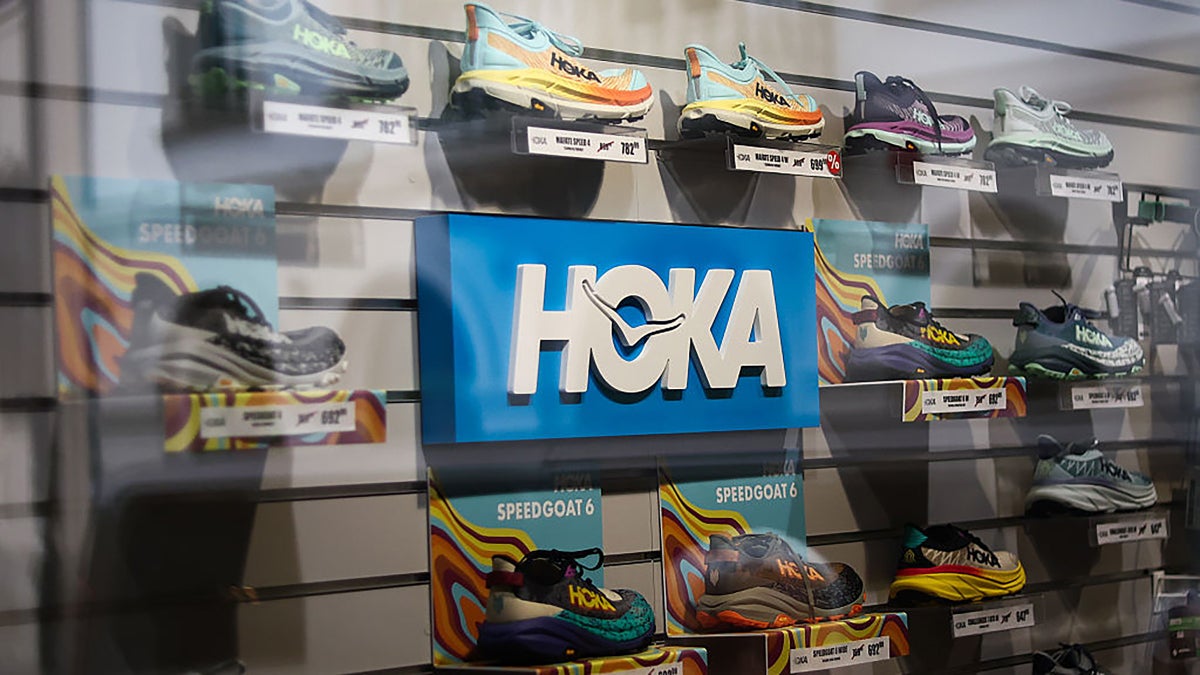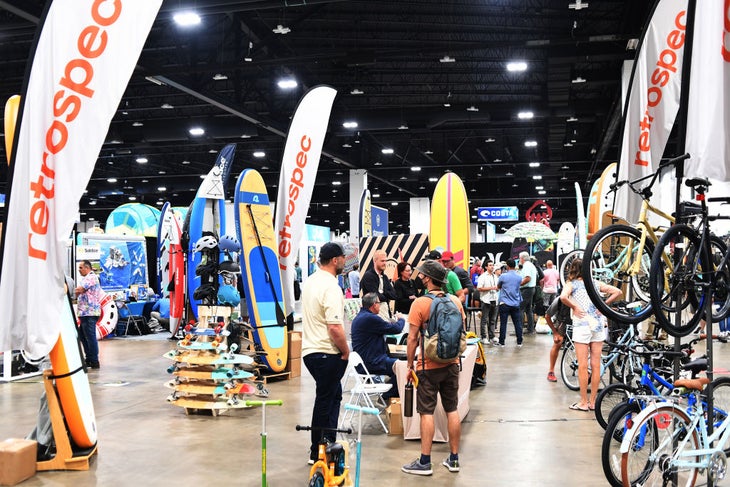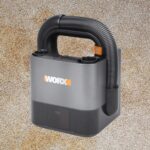
The bikes, backpacks, tents, and other outdoor gear on our wishlists about to get more expensive—a result of America’s burgeoning trade war.
That’s the consensus of outdoor industry experts who spoke to Outside. As trade debates evolve and escalate on a daily basis, instability is the only constant right now in the outdoor industry, and sources told Outside that we are entering perhaps the most volatile and unpredictable period for businesses in recent memory.
“It’s the only conversation that’s going on right now in the industry,” said Eoin Comerford, the former CEO of Moosejaw who now works with many emerging outdoor brands through his company Outsize Consulting. “Nobody is thinking about anything but tariffs right now.”
On April 9 the U.S. government imposed a series of tariffs on trade partners: imports from all foreign countries are currently subject to a ten percent baseline tariff. President Donald Trump also announced reciprocal tariffs on goods imported from 57 of the U.S.’s largest trade partners. Those include 49 percent tariffs on imports from Cambodia, 46 percent on Vietnam, and 32 percent on Taiwan, all of which are countries that produce goods or materials that American outdoor brands import.
Then, a few hours later, the President delayed the reciprocal tariffs until July 9, but increased tariffs on Chinese goods, which now stand at 245 percent.

Tariffs are taxes levied on goods imported from another country, paid to the home country’s government by the importer. The Trump Administration has said that the tariffs will level imbalances with the countries who exact charges on American imports as well as supposedly bring back domestic manufacturing. But some representatives from outdoor brands told Outside that this change will be impossible without added infrastructure, due to the outdoor industry’s reliance on imported goods and materials.
Cassie Abel, the founder of women’s technical apparel brand Wild Rye, tried to manufacture products in the U.S. and doing so almost killed her business. Delivery delays, poor communication, production flaws, and labor costs made it impossible to produce in the U.S.
So she moved production to a factory in China that has a Vietnamese satellite. After growing the direct-to-consumer side of the brand by 75 percent over last year, announcing a rebrand, and collaborating with Smith, the tariffs are overshadowing any wins. She and her team are figuring out how to reduce expenses because cash is about to become scarce.
Brand leaders have been forced to become overnight experts in trade policy, an incredibly nuanced and complicated topic, says Jacylyn Levy, senior director of advocacy and government affairs at Outdoor Industry Association (OIA). In a recent report, OIA found that 84 percent of member businesses surveyed said they will be impacted by new tariffs, resulting in millions of dollars in financial losses and affecting hundreds of outdoor products.
For the past two weeks, outdoor industry professionals have been working around the clock negotiating with manufacturing and retail partners to share some of the tax burden. Manufacturers from Asia who spoke to Outside at the Functional Fabric Fair in Portland, Oregon said they also have little to no margins to absorb costs. “It’s a question of how do you spread the pain of that incremental tax,” said Travis Campbell, the owner and CEO of Eagle Creek.
In a letter to lawmakers, Campbell said Eagle Creek has an outstanding purchase order of $1.8 million on imported goods from Indonesia, which would normally accrue $260,000 in duties. With the reciprocal tariffs though, the company would have to pay a total of $840,000 in duties. “Our business simply cannot afford this cost,” Campbell wrote.
Ultimately, as hard as businesses may try to avoid it, a portion of that cost will get passed onto their customers. Every source who spoke to Outside said that prices on outdoor products are inevitably going to rise and, in some cases, rise drastically.

“Even though we may see some brands and retailers shutter their doors, the big loser here is the consumer,” said Matt Powell, a longtime outdoor industry data analyst and founder of Spurwink River Consulting.
Missy Park, the founder of women’s activewear brand Title Nine, broke down the math in a recent Instagram video using a $100 pair of elasticated pants as an example. Before tariffs, the business made $2 in net profit on each pair. After the latest round of tariffs, the business now owes $20 to the government on each pair sold.
“You get the same pair of pants,” Park says in the video. “Right now, we really don’t know if the prices are going to go up. But one thing you can count on is that we’re scrambling to make the math work for you, and for us, and for our whole community of suppliers.”
Abel is in the same boat. She’s still uncertain when and by how much Wild Rye’s prices will increase. “There is no world in which we can afford to stay in business and not raise prices,” she said.
While some brands may increase prices immediately to soften some of the financial blow, others are waiting until final figures on tariffs stabilize. Comerford says one cost-saving option is to cut products that already have low margins. Another is to delay shipments from their overseas factories.
Brands that over-ordered product during the pandemic in anticipation of high demand and finally sold through the surplus inventory aren’t necessarily excited to fill their shelves again. But if they don’t expedite inventory from abroad, they may be left empty handed.
“If you’re managing a business here, the amount of uncertainty is just soul-crushing,” Comerford said. “It has paralyzed the industry.”
As of right now, Gloria Hwang, founder and CEO of helmet maker Thousand, told factory partners to hold off making two entirely new products: a helmet and a bike lock. She says they’ve rarely raised prices in their decade in business but have few options at the current tariff rate, which, for Thousand, ranges between 30 percent and 60 percent.
When Hwang spoke to us on April 7, a shipping container of Thousand products was on the water, set to arrive at a U.S. port. Had the U.S. not delayed the reciprocal tariffs two days later, she would have had to pay an extra six figures in duties that she had not forecasted, she said.
Those costs have the potential to ruin her business.
“Unfortunately, it’s gonna thin the herd,” said Mike Lewis, CEO of Texas-based Bison Coolers, which manufactures domestically in Tennessee and Colorado and overseas in China. “Any business that was in distress before you got to this point, they’re gonna go out of business because they’re like, we can’t compete.”
Already, the outdoor industry was experiencing hardship and recovering from the boom-and-bust repercussions from the pandemic. The turbulence has resulted in layoffs and staff downsizing, revenue shortfalls, product inventory imbalances, and snarled supply chains.
Tariffs are the cherry on top of the teetering sundae.
If there was ever an upside of the continued instability, it’s that business leaders have learned to be nimble, said Steve Bick, CEO and owner of Boundary Supply. The travel pack brand sources fabrics and other supplies in the U.S. but sends products to Cambodia for assembly. “My gamble is that this will be resolved relatively shortly,” he said. “This is a temporary blip.”
Even if he’s right, perhaps the worst impacts of the trade war are the uncertainty for long-term planning and the stunting of innovation. “It’s very hard to make any business decisions when policy continues to change month after month,” Hwang said.
Lewis added: “One bad decision or one calculated risk could really come back to haunt you.”
Whether the economy stabilizes soon or not, the damage to consumer confidence has already been done, Campbell says. They’re either grabbing up items before prices go up and inventory wanes or they’re not buying anything at all out of fear of recession.
“It’s gonna be ugly for a while,” Abel said.
The post The Price of Outdoor Gear is About to Go Way Up appeared first on Outside Online.















